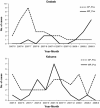Epidemiology of respiratory infections caused by atypical bacteria in two Kenyan refugee camps
- PMID: 21701900
- PMCID: PMC7087906
- DOI: 10.1007/s10903-011-9494-1
Epidemiology of respiratory infections caused by atypical bacteria in two Kenyan refugee camps
Abstract
Chlamydia pneumoniae, Mycoplasma pneumoniae, and Legionella spp. are common causes of atypical pneumonia; however, data about these atypical pathogens are limited in the refugee setting. Paired nasopharyngeal and oropharyngeal specimens were collected from patients with respiratory illness presenting to healthcare centers in two refugee camps in Kenya. The specimens were tested for C. pneumoniae, M. pneumoniae, and Legionella spp. as well as eight respiratory viruses. Atypical pathogens were detected in 5.5% of the specimens of which 54% were co-infected with at least one of the eight viruses tested. Patients positive for atypical bacteria co-infected with virus were significantly more likely to have severe acute respiratory illness than patients infected with only atypical bacteria (P = 0.04). While the percentage of atypical pathogens identified was lower than expected, we found a significant relationship between atypical bacterial-viral co-infection and severity of disease in this refugee population.
Figures
References
-
- Gray GC, Rodie GR, Matras-Maslin VC, Honein MA, Ismail EA, Botros BA, Soliman AK, Merrell BR, Wang SP, Grayston JT. Serologic evidence of respiratory and rickettsial infections among Somali refugees. Am J Trop Med Hyg. 1995;52(4):349–353. - PubMed
-
- World Health Organization: WHO Regional Office for Europe guidance for influenza surveillance in humans. Available from: http://www.euro.who.int/__data/assets/pdf_file/0020/90443/E92738.pdf (2009).
-
- World Health Organization: IMCI integrated management of childhood illness. Available from: http://whqlibdoc.who.int/publications/2005/9241546441.pdf (2005).
MeSH terms
LinkOut - more resources
Full Text Sources
Miscellaneous


